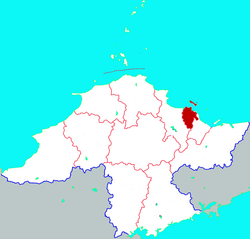Zhifu, Yantai
Zhifu District
芝罘区 Chefoo | |
|---|---|
 View of Zhifu Bay from Yantai Mountain | |
 Location in Yantai | |
| Coordinates: 37°32′13″N 121°24′05″E / 37.53694°N 121.40139°E | |
| Country | People's Republic of China |
| Province | Shandong |
| Prefecture-level city | Yantai |
| Area | |
• Total | 179.2 km2 (69.2 sq mi) |
| Population (2017) | |
• Total | 701,000 |
| • Density | 3,900/km2 (10,000/sq mi) |
| Time zone | UTC+8 (China Standard) |
| Postal code | 264001 |
| Website | www |
| Zhifu, Yantai | |||||||||||||
|---|---|---|---|---|---|---|---|---|---|---|---|---|---|
| Traditional Chinese | 芝罘區 | ||||||||||||
| Simplified Chinese | 芝罘区 | ||||||||||||
| |||||||||||||
Zhifu District is an urban district of the prefecture-level city of Yantai in Shandong Province, China. Zhifu is the center of Yantai, Yangtai Mountain, Yantai Port and former city hall are all located in this district.
Name
[edit]Zhifu gets its name from the land-tied island on its coast, whose shape is like a lingzhi, thus it was called 'zhi' (芝), and 'fu' (罘) means a barrier. This name was first recorded when Qin Shi Huang sent his fleet for elixir of life.
Zhifu opened its port in 1861, after which it had frequent interactions with western countries, and its name was romanized in various ways as Chefoo,[1] Che-foo,[2] Chi-fu,[3] and Chih-fou. Although this name was used for the city by foreigners prior to the Communist victory in the Chinese Civil War, the locals referred to the settlement as Yantai (q.v.) throughout.[2][3]
History
[edit]The area was inhabited as early as the Neolithic period by the Dongyi people. It was part of Qi County during the Qin dynasty. Formerly a small unwalled fishing village, Zhifu grew when its harbor was chosen to act as the international port for the larger city of Tengchow (now Penglai) nearby. It now forms part of the urban core of Yantai.
After the Second Opium War, the Qing government opened its 13 cities for trade, and Zhifu was included. Thereafter, a total of 17 countries, including Britain, France, and the United States, successively established consulates in Zhifu.
On February 14, 1862, the Deng-Lai-Qing Bianbei Circuit (登萊青兵備道) was relocated from Laizhou Prefecture to Zhifu, with Circuit Intendant Chongfang concurrently serving as Superintendent of the Dong Customs.
In 1877, Chefoo International Settlement was open.
Administrative divisions
[edit]As of 2012[update], this district is divided to 12 subdistricts.[4]
- Subdistricts
|
|
Education
[edit]As of the end of 2018, Zhifu District had a total of 5 secondary vocational schools with 8,764 enrolled students; 1 senior high school with 2,696 students; 6 complete middle schools (offering both junior and senior high school education) with 23,085 students; 2 twelve-year integrated schools (covering primary to high school) with 5,617 students; 7 nine-year integrated schools (covering primary to junior high) with 10,267 students; 12 junior high schools with 9,172 students; 40 primary schools with 34,726 students; and 114 kindergartens with 24,775 children. Additionally, there were 2 special education schools serving 257 students.
Chefoo School, which was established by American Presbyterian missionaries aiming to educate foreign children, was in Zhifu previously.
References
[edit]Citations
[edit]- ^ Postal Map Romanization.
- ^ a b EB (1878).
- ^ a b EB (1911), p. 132.
- ^ 烟台市-行政区划网 www.xzqh.org (in Chinese). XZQH. Retrieved 2012-05-24.
Bibliography
[edit]- , Encyclopædia Britannica, vol. V (9th ed.), New York: Charles Scribner's Sons, 1878, p. 455.
- . Encyclopædia Britannica. Vol. 6 (11th ed.). 1911. pp. 132–3.

